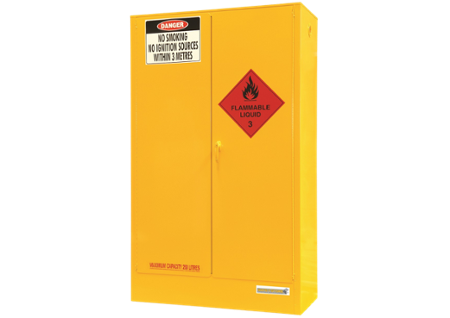When selecting a chemical safety cabinet for your workplace, you’ll have to consider a range of factors. And one of the most significant things you’ll have to think about is what capacity is right for your operations. However, don’t be fooled into thinking that this is a simple, quick decision. It’s worth taking a bit of time to look at the benefits of various models to determine which chemical safety cabinet capacity is best for your workplace. In this post, we’ll be diving into this topic by explaining the dangers associated with overloading safety cabinets. We’ll also be offering some helpful tips on how to choose a cabinet that works for your business.
What Is A Maximum Capacity Rating?
So, what exactly is a maximum capacity rating in relation to chemical storage equipment?
When browsing DG storage, you’ll see the maximum capacity rating clearly printed on the front of the indoor cabinet or outdoor chemical storage container.
Always consider the maximum capacity of your cabinet, and ensure the signage stays intact after installation.
Capacities of indoor DG storage equipment are usually smaller than the outdoor storage containers, due to the requirements surrounding the maximum quantities of hazardous chemicals allowed indoors.
The maximum capacity rating must be displayed clearly on your cabinet as part of your ongoing compliance obligations. Your staff must all be aware of the capacity of your cabinet, so they can carry out their daily tasks without risk of overloading the cabinet.
Dangers With Overloading A Chemical Storage Cabinet
The number one rule when selecting a cabinet is to ensure that you’re choosing a model that comfortably accommodates the largest amount of chemicals that you would choose to store in that particular chemical storage cabinet (we’ll get more into this particular process later in the blog).
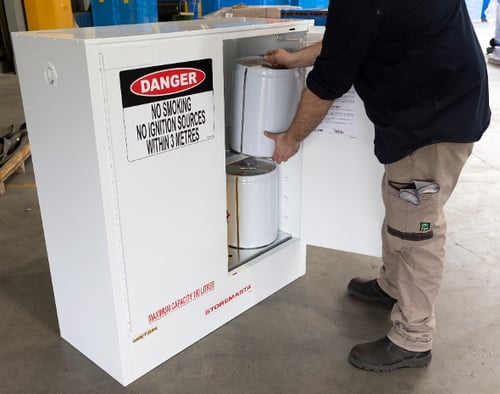
You must train your staff to adhere to the maximum capacity requirements of each of your chemical cabinets to ensure safety and compliance.
Overloading cabinets past their maximum capacity rating is an extremely dangerous and reckless practice that can cause a range of safety issues, such as:
- Affecting integrity of cabinet – your equipment was specifically designed to house a maximum volume of chemicals. When stacking and loading your cabinet past the required capacity, you could be damaging the integrity of the adjustable shelves, the lugs and even the cabinet itself.
- Hazardous vapours – hazardous vapours and gases can be emitted when chemical containers are opened by staff, there are leaks and spills, or due to poor housekeeping practices. Overloading your cabinet increases the risk that chemicals may spill or leave chemical residue in the cabinet or on the outside of containers.
- Overfilling of spill sump – your spill sump is designed to contain a certain volume of liquid chemical. By overfilling your cabinet, you may be compromising the effectiveness of the spill containment sump due to excessive chemicals stored within the cabinet.
- Doors unable to close or lock – crowded shelves on a chemical cabinet may prohibit the doors to close properly. This will stop the doors from fitting as they should, and may also stop the doors from locking.
- Self-closing mechanism disabled – chemical cabinets will generally be fitted with a self-closing mechanism which closes the doors once staff have finished their duties. Overcrowding a cabinet may cause this mechanism to fail, which can render your cabinet non-compliant.
REMEMBER: Each class of chemical should be housed in a particular storage cabinet that’s been manufactured to meet the relevant Australian Standard. Choosing a compliant cabinet that meets these requirements means that you’re providing the best protection for your business against chemical hazards.
What Do You Need To Consider When Selecting A Maximum Capacity?
So, you’ve got approximately 120 litres of chemicals (in the one dangerous goods class) currently onsite? Then you’ll probably consider choosing an indoor chemical cabinet with a 160 litre capacity, right?
Well, not quite. Before you add the cabinet to your cart, you may want to stop and consider a few more factors that can greatly influence your decision.
When looking at the capacities for chemical storage equipment, there are some crucial considerations that will factor into your decision making, such as the relevant requirements, the lifecycle of your business and the type of chemical packages that you’re storing.
Let’s have a look at these considerations below:
Capacity Limitations
The capacity of dangerous goods storage equipment can range widely in size.
Indoor cabinets, such as our flammable cabinet with a 15 litre capacity, are ideal for workplaces where there is a small amount of chemicals within the Class 3 category. Indoor safety cabinets generally range from a compact 15 litres to an expansive 850 litre capacity (see our large capacity cabinets).
However, larger volumes of chemicals may be safer in outdoor storage.
Outdoor chemical storage containers, just like indoor cabinets, can also vary in size, but models start from a 80 litre capacity. Dangerous goods containers, which are a typically large relocatable model, can comfortably house 4,000 litres of chemicals – in the one unit.
Depending on the volume (and class) of chemical that you’re looking to store, you’ll have to consider if you’ll be looking at indoor chemical storage cabinets or outdoor dangerous goods storage equipment.
REMEMBER: If you’re storing large volumes of chemicals, you may need to consider an outdoor storage option such as our 20ft dangerous goods container, which features a whopping a 8,000 litre chemical capacity.
What Are The Requirements?
As we touched on earlier, when storing larger volumes of dangerous goods, it’s generally a safer option to store these chemicals in an outdoor chemical storage container.
There are a range of requirements from the Australian Standards that restrict the volume of hazardous chemicals that you can store indoors.
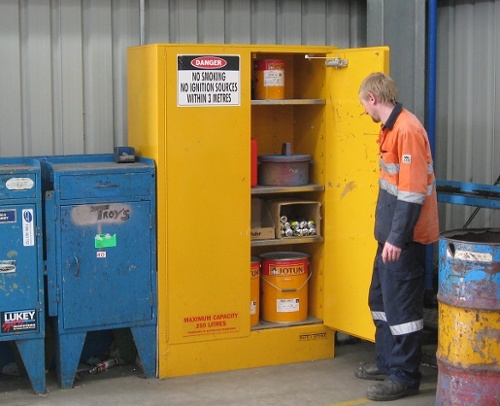
Indoor chemical storage cabinets are generally smaller in capacity due to the increased risk of storing hazardous substances in a confined environment.
These requirements may include restrictions on the aggregate volume of dangerous goods that can be stored indoors, as well as the location and number of chemical cabinets which are allowed within a building — or on a particular floor.
Larger capacity cabinets may also be subject to further requirements which may affect where they are installed in your organisation. This will also influence your decision when selecting a suitable cabinet model.
IMPORTANT: Flammable liquid storage, for example, is restricted in capacity due to the chemical class’ ability to ignite and cause fires and explosions. Refer to the appropriate Australian Standard to learn more about the requirements for your chemical class.
Where Is Your Business Heading?
Have you considered the lifecycle of your business when looking at dangerous goods storage equipment? It may seem like an unusual consideration, but how your business grows over the coming months and years can affect your chemical storage needs.
While chemical cabinets are an investment, it is often more cost-effective to choose a larger cabinet that can accommodate the growing needs of your workplace.
Smaller models often work out to be more expensive per litre of chemical storage, so considering how your business will develop in the short- and long-term can help you better select equipment that will remain suitable and effective in the future.
What Packages Are Being Stored?
Chemical packages come in all shapes and sizes – from tiny bottles to medium-sized drums and large bags. While your maximum capacity is useful when determining the volume of chemicals that you’ll be storing, there may be some work to do when figuring out how to stack and load your cabinet with the packages that you’re storing.
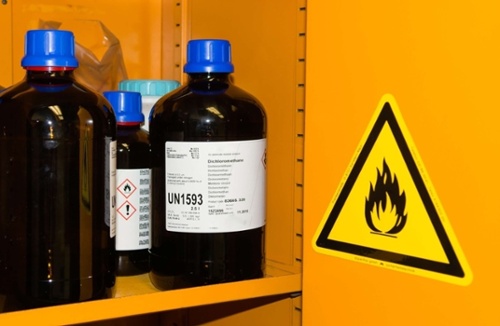
Different chemical packages will take up different amounts of spaces, so make sure you’re choosing a cabinet that fits your needs.
Stacking multiple chemical bottles on a shelf will create a smaller footprint than if you were stacking drums. However, drums can be stacked (usually, two high maximum) in a cabinet, which allows a good use of storage space. Chemical bags will also sit differently on the shelves, with their malleable shape allowing more product to be placed on each adjustable shelf.
We recommend calculating the amount of product that will fit into your particular cabinet. This will be based on the dimensions of the cabinet (width, depth, height) divided by the diameter of the package.
An example of this quick calculation appears below:
SC250 Safety Cabinet
Internal Dimensions: 1503mmH (take shelf thickness away (28mm x 3 = 84) =1419mmH ) x 1018mmW x 420mmD
20L Drum
360mmH, 300mm diameter
Storage capacity
(1419/360= 3.9) = 3 high
(1018/300= 3.39) = 3 wide
(420/300=1.4) = 1 deep
3 wide x 1 deep = 3
3 x 3 high = 9 x 20L drums total
Considering how your packages will be placed in the cabinet may give you a better understanding of the capacity of cabinet that you’ll require.
What Is Best For Operations?
When handling and transferring any type of hazardous substance, a good rule of thumb is to try to minimise the travelling distance between handling and storage areas. This is to prevent chemical leaks and spills when staff are transporting chemical packages.
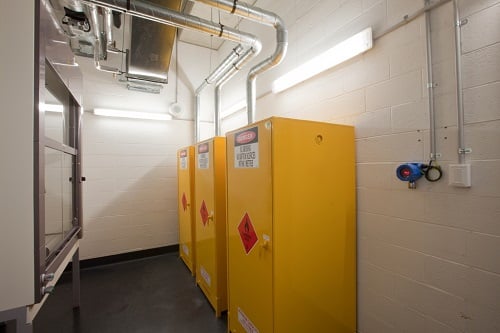
Your chemical cabinet should be installed in a safe, convenient position within your business.
Consider how your work practices are carried out, as well as the individual needs of each section of your business. Would it be safer and more convenient to have a large cabinet in a general work space — or multiple smaller cabinets installed in a variety of work areas?
REMEMBER: If you’re not sure what capacity cabinet you require, consider speaking with a Dangerous Goods Specialist who can give you practical advice on the best piece of equipment to suit your chemicals — and your operations.
Selecting Safety Cabinets
Would you like to know more about safety cabinets and their risk control features? The Design Requirements For Different Dangerous Goods Storage Cabinets details how each class of cabinet works to protect your business from the hazards associated with that particular class of chemical. Download your own copy now to learn more about reducing chemical risk in your organisation.
Joining the team as a Dangerous Goods Storage Consultant, Melissa Hampton became Storemasta's Marketing Manager in late 2021. With extensive knowledge and experience in chemical compliance, Melissa is responsible for leading the Marketing team and helping shape their marketing strategy. In her spare time, you can find Melissa hiking, swimming and enjoying the great outdoors in beautiful north-west Tasmania.
